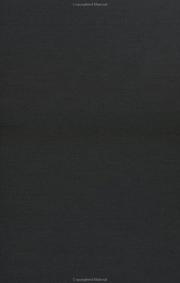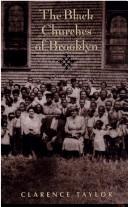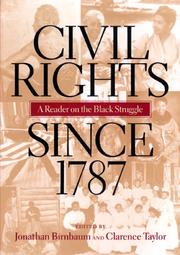| Listing 1 - 10 of 10 |
Sort by
|

ISBN: 0203616634 1299478476 1136061703 9781136061707 9780203616635 9780203616635 9781136061868 113606186X 9781136061783 1136061789 0415933269 9780415933261 0415933277 9780415933278 9781299478473 Year: 2002 Publisher: New York Routledge
Abstract | Keywords | Export | Availability | Bookmark
 Loading...
Loading...Choose an application
- Reference Manager
- EndNote
- RefWorks (Direct export to RefWorks)
Clarence Taylor shows how black leaders were able to carve out a space for religion as part of a progressive political agenda and reveals the complex and innovative ways that black religious notions were continually reconstructed to accommodate the communities they served.
African American clergy --- African American intellectuals --- African American leadership. --- African Americans --- Afro-American clergy --- Clergy, African American --- Negro clergy --- Clergy --- Afro-American leadership --- Leadership, African American --- Negro leadership --- Leadership --- Political activity. --- Civil rights. --- Religion.
Book
ISBN: 1479862452 9781479862450 Year: 2019 Publisher: New York: New York University press,
Abstract | Keywords | Export | Availability | Bookmark
 Loading...
Loading...Choose an application
- Reference Manager
- EndNote
- RefWorks (Direct export to RefWorks)
A story of resistance, power and politics as revealed through New York City's complex history of police brutality The 2014 killing of Michael Brown in Ferguson, Missouri was the catalyst for a national conversation about race, policing, and injustice. The subsequent killings of other black (often unarmed) citizens led to a surge of media coverage which in turn led to protests and clashes between the police and local residents that were reminiscent of the unrest of the 1960s. Fight the Power examines the explosive history of police brutality in New York City and the black community's long struggle to resist it. Taylor brings this story to life by exploring the institutions and the people that waged campaigns to end the mistreatment of people of color at the hands of the police, including the black church, the black press, black communists and civil rights activists. Ranging from the 1940s to the mayoralty of Bill de Blasio, Taylor describes the significant strides made in curbing police power in New York City, describing the grassroots street campaigns as well as the accomplishments achieved in the political arena and in the city's courtrooms. Taylor challenges the belief that police reform is born out of improved relations between communities and the authorities arguing that the only real solution is radically reducing the police domination of New York's black citizens.
Book
ISBN: 1479851590 Year: 2019 Publisher: New York : Baltimore, Md. : New York University Press, Project MUSE,
Abstract | Keywords | Export | Availability | Bookmark
 Loading...
Loading...Choose an application
- Reference Manager
- EndNote
- RefWorks (Direct export to RefWorks)
A story of resistance, power and politics as revealed through New York City’s complex history of police brutalityThe 2014 killing of Michael Brown in Ferguson, Missouri was the catalyst for a national conversation about race, policing, and injustice. The subsequent killings of other black (often unarmed) citizens led to a surge of media coverage which in turn led to protests and clashes between the police and local residents that were reminiscent of the unrest of the 1960s.Fight the Power examines the explosive history of police brutality in New York City and the black community’s long struggle to resist it. Taylor brings this story to life by exploring the institutions and the people that waged campaigns to end the mistreatment of people of color at the hands of the police, including the black church, the black press, black communists and civil rights activists. Ranging from the 1940s to the mayoralty of Bill de Blasio, Taylor describes the significant strides made in curbing police power in New York City, describing the grassroots street campaigns as well as the accomplishments achieved in the political arena and in the city’s courtrooms.Taylor challenges the belief that police reform is born out of improved relations between communities and the authorities arguing that the only real solution is radically reducing the police domination of New York’s black citizens.
African Americans --- Police brutality --- Violence against --- History.
Book
ISBN: 0823232913 9786613297136 0823240878 082323746X 1283297132 0823249174 9780823240876 9780823232918 9780823237463 9780823249176 9780823232895 0823232891 Year: 2011 Publisher: New York Fordham University Press
Abstract | Keywords | Export | Availability | Bookmark
 Loading...
Loading...Choose an application
- Reference Manager
- EndNote
- RefWorks (Direct export to RefWorks)
Since the 1960's, most U.S. History has been written as if the civil rights movement were primarily or entirely a Southern history. This book joins a growing body of scholarship that demonstrates the importance of the Northern history of the movement. The contributors make clear that civil rights in New York City were contested in many ways, beginning long before the 1960's, and across many groups with a surprisingly wide range of political perspectives. Civil Rights in New York City provides a sample of the rich historical record of the fight for racial justice in the city that was home to the nation’s largest population of African-Americans in mid-twentieth century America. The ten contributions brought together here address varying aspects of New York’s civil rights struggle, including the role of labor, community organizing campaigns, the pivotal actions of prominent national leaders, the movement for integrated housing, the fight for racial equality in public higher education, and the part played by a revolutionary group that challenged structural, societal inequality. Long before the Montgomery Bus Boycott, the Reverend Adam Clayton Powell Jr. helped launch the Harlem Bus Boycott of 1941. The New York City’s Teachers’ Union had been fighting for racial equality since 1935. Ella Baker worked with the NAACP and the city’s grassroots movement to force the city to integrate its public school system. In 1962, a direct action campaign by Brooklyn CORE, a racially integrated membership organization, forced the city to provide better sanitation services to Bedford-Stuyvesant, Brooklyn’s largest black community. Integrating Rochdale Village in South Jamaica, the largest middle-class housing cooperative in New York, brought together an unusual coalition of leftists, liberal Democrats, moderate Republicans, pragmatic government officials, and business executives. In reexamining these and other key events, Civil Rights in New York City reaffirms their importance to the larger national fight for equality for Americans across racial lines.

ISBN: 0231099800 Year: 1994 Publisher: New York Columbia University Press
Abstract | Keywords | Export | Availability | Bookmark
 Loading...
Loading...Choose an application
- Reference Manager
- EndNote
- RefWorks (Direct export to RefWorks)
Book
ISBN: 9780231526487 Year: 2011 Publisher: New York, NY
Abstract | Keywords | Export | Availability | Bookmark
 Loading...
Loading...Choose an application
- Reference Manager
- EndNote
- RefWorks (Direct export to RefWorks)
Book
ISBN: 9781479851591 1479851590 9781479862450 1479862452 Year: 2018 Publisher: New York, NY
Abstract | Keywords | Export | Availability | Bookmark
 Loading...
Loading...Choose an application
- Reference Manager
- EndNote
- RefWorks (Direct export to RefWorks)

ISBN: 0814782493 Year: 2000 Publisher: New York London New York University Press
Abstract | Keywords | Export | Availability | Bookmark
 Loading...
Loading...Choose an application
- Reference Manager
- EndNote
- RefWorks (Direct export to RefWorks)
Book

ISBN: 9780823237463 Year: 2011 Publisher: New York, NY
Abstract | Keywords | Export | Availability | Bookmark
 Loading...
Loading...Choose an application
- Reference Manager
- EndNote
- RefWorks (Direct export to RefWorks)
Book

ISBN: 0231544049 9780231544047 9780231182218 9780231182201 Year: 2019 Publisher: New York, NY
Abstract | Keywords | Export | Availability | Bookmark
 Loading...
Loading...Choose an application
- Reference Manager
- EndNote
- RefWorks (Direct export to RefWorks)
Over the course of the twentieth century, education was a key site for envisioning opportunities for African Americans, but the very schools they attended sometimes acted as obstacles to black flourishing. Educating Harlem brings together a multidisciplinary group of scholars to provide a broad consideration of the history of schooling in perhaps the nation's most iconic black community.The volume traces the varied ways that Harlem residents defined and pursued educational justice for their children and community despite consistent neglect and structural oppression. Contributors investigate the individuals, organizations, and initiatives that fostered educational visions, underscoring their breadth, variety, and persistence. Their essays span the century, from the Great Migration and the Harlem Renaissance through the 1970s fiscal crisis and up to the present. They tell the stories of Harlem residents from a wide variety of social positions and life experiences, from young children to expert researchers to neighborhood mothers and ambitious institution builders who imagined a dynamic array of possibilities from modest improvements to radical reshaping of their schools. Representing many disciplinary perspectives, the chapters examine a range of topics including architecture, literature, film, youth and adult organizing, employment, and city politics. Challenging the conventional rise-and-fall narratives found in many urban histories, the book tells a story of persistent struggle in each phase of the twentieth century. Educating Harlem paints a nuanced portrait of education in a storied community and brings much-needed historical context to one of the most embattled educational spaces today.
African Americans --- Discrimination in education --- Racism in education --- School improvement programs --- Improvement programs, School --- Instructional improvement programs --- Programs, School improvement --- School self-improvement programs --- School management and organization --- Afro-Americans --- Black Americans --- Colored people (United States) --- Negroes --- Africans --- Ethnology --- Blacks --- Education --- Educational discrimination --- Race discrimination in education --- Affirmative action programs in education --- Segregation in education --- History --- Social conditions --- Black people
| Listing 1 - 10 of 10 |
Sort by
|

 Search
Search Feedback
Feedback About UniCat
About UniCat  Help
Help News
News